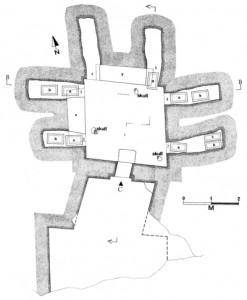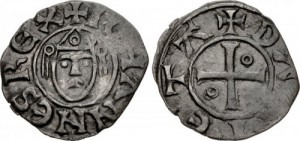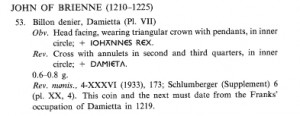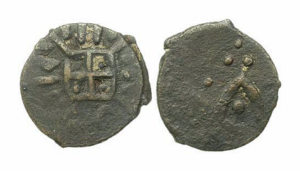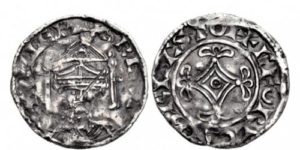John of Brienne, Templar “King of Jerusalem” and the Talpiot “Jesus” Tomb
Posted by James Tabor on jamestabor.com
Earlier this week I wrote a short post about Scott Wolter’s claim on the recent History 2 Channel program, “Tracking the Templars,” part of his popular series “America Unearthed,” that the famous Crusader order we know as the Knights Templar must have known about the Talpiot “Jesus” tomb. Simcha Jacobovici has now weighed in asserting that the Templar coin that Wolter displayed, with its symbolism matching the facade of the tomb, is a “smoking gun” connecting the Templars with the tomb. You can read his reasoning here, plus links to materials he presented back in 2007 in connection with his film, “The Lost Tomb of Jesus,” here. I find the coin quite intriguing but as I noted in my earlier post I find Wolter’s overall “Holy Blood, Holy Grail” thesis heavy on speculation.
Here is what we know about the history of this 1st century CE tomb. Although it does appear that the Talpiot “Jesus” tomb had been violated prior to 1980 when it was excavated by the Israel Antiquities team, just when and by whom it is hard to say. There was no blocking stone ever found that would have sealed the entrance of the tomb. As a consequence large amounts of the local terra rosa soil had washed into the tomb to the point of even covering the tops of the ossuaries in the six burial niches or kokhim. There were three skulls found on the floor of the tomb as well as other bones, including vertebrae, shoulder bones, and limbs. Were the skulls placed there purposely or were they, along with the other bones, unceremoniously swept to the floor from the two shelves or arcosolia. If the latter is the case, this seems to indicate some kind of violation, rather than a respectful treatment of the remains of the dead by the family in antiquity. Two of the skulls were found just below the shelves that once held corpses in a state of decomposition and a third was just to the right of the entrance to the tomb. Some have noted a “triangular” pattern in the placement of the skulls, perhaps indicating some ritual or ceremonial purposes. In our book, The Jesus Discovery, pp. 21-33 we provide maps, photos, and a documented comprehensive analytical overview of all we know of the 1980 excavation of the tomb. I know of no other source as complete as our treatment therein.
In Shimon Gibson’s original drawing he presents the skulls clearly and precisely. He told me that Joseph Gat, the excavator, had removed them and took great care to show Gibson precisely where they had been on the floor so he could include them in his drawing shown here, boldly labeled. Both Gibson and Gat though the skulls were one of the oddest features of this tomb. Strangely, when Amos Kloner published the official report on the 1980 excavation in 1996–only after it came to world attention–the skulls were airbrushed out of Gibson’s drawing:
There are really two separate questions here. When was the tomb violated and by whom? When was the tomb left open with the blocking stone removed? And is there any evidence, other than the imagery on this coin, that would connect the time of the pre-1980 tomb entry to the Crusaders of the 13th century? I am not aware of anything of this sort that would give us even an approximate date. It is entirely possible that the evidence of the skeletal materials and skulls on the floor are unconnected to the tomb being left open–with the blocking stone missing and soil beginning to wash in. In other words, the tomb might have been violated and resealed, and at some subsequent date left open–even in more recent times. After all, the washed in soil had not completely filled the tomb to the ceiling, as might have been the case had it been left open for nearly a thousand years. I know of other three other such 1st century tombs in the Hinnom Valley that have never been excavated and are completely filled with soil–but were likely violated at some earlier time, as the blocking stones are missing.
But what about the Crusader period Templar coin? Norman Stambaugh was kind enough to look up a bit more of the evidence we have regarding this coin and also pointed out to me a second one that seems to have a version of the same “Chevron” with a circle/dot pattern. His source was History of the Crusades, vol. 6, edited by Harry W. Hazard and Norman P. Zacour (University of Wisconsin, 1989). You can access it on-line here. Wolter’s coin is item 53, page 416, “Coinage of the Kings of Jerusalem.” The photo in the on-line edition of the book is a bit fuzzy for web display but here is a very sharp image of the same coin from an auction house. Looks like it recently sold for $2200! Thanks to Thomas Wolke for the link:
This is of course a coin celebrating the triumph of John Brienne, the prominent French noblemen of the 5th and 6th Crusades who was declared “King of Jerusalem,” and whose career is one of the most colorful in the period. He had a daughter, Yolanda, by Maria of Montferrat, his first wife of his three marriages, who subsequently ruled as “Queen of Jerusalem.” John and Maria were jointly coronated as “King and Queen” of Jerusalem. The face on the coin would of course be his, and the editors interpret him as wearing a “triangular crown with pendants”–the top of which seems to be uncanny close to the symbol on the facade of the Talpiot “Jesus” tomb. Looking at the other extant coins from the “Kingdom of Jerusalem” from this period the representation of a “face” appears to be unique. At first glance I thought the head piece might be some kind of Crusader “helmet,” but given the inscription: IOHANNES REX–it is clearly a royal crown or perhaps a “mitre” of a very unique style, and it is quite different from the more typical royal crowns shown on John and Maria in a coronation engraving of the period. So what did it symbolize?
In some ways the second coin is even more fascinating, in that it appears on the observe to have a symbol that is quite precisely like the Talpiot “Jesus” tomb facade, including the top little “chimney” that Simcha has emphasized in his post. The editors find it totally unique and don’t even hazard a guess as to its meaning and significance. The three dots to the left of the symbol add all the more to the intrigue. It is from the same period, badly struck, copper, and described thus:
Crusaders, Lordship of Sidon, Anonymous Copper, c. 1250 – 1291”, and “uneven strike, 1.682g, 16.9mm, obverse cross, pellet in each angle, within square with bar from each corner, very crude inscription, H…O…; reverse pellet in triangle, pellets around. Totally unique, no other coin like it any any reference. From the collection of Alex G. Malloy, former dealer for 40 years and co-author of “Coins of the Crusader States.”
During the First Crusade, on December 4, 1110, Sidon was captured by King Baldwin of Jerusalem and King Sigurd of Norway. It became the center of the Lordship of Sidon, an important seigneury in the Kingdom of Jerusalem. Under the crusaders, Sidon was sacked several times and nearly destroyed by the Saracens in 1249, and again by the Mongols in 1260. About month after the capture of Acre in late spring 1291, Al-Ashraf Khalil sent a force led by Emir al-Shuja’i to Sidon. The Knights Templar had moved their treasure to Sidon and taken refuge inside a sea castle on an isle about 90 meters from the shore. When the Sultan’s forces began to build a bridge the knights escaped by sea and crusader rule of Sidon ended. The fabric and crudeness in design of the anonymous copper pieces, such as this coin, put them in into a similar time frame as the anonymous copper of Tripoli and Antioch, perhaps during the Mongol invasions of the 1250s or perhaps later.
There is a much earlier coin of William I “The Conquerer” (1066-1087), minted around 1070 that seems to show the King wearing some kind of crown but with a “temple” like facade behind his head that has some similarities to the Chevron and circle imagery.

